
Historic old Fort Parker is on Park Road 35 just off Hwy 14 between Groesbeck & Mexia in Limestone county.
A bit of history in your own back yard. Old Fort Parker is a great place to allow your children to view the old west for themselves. Just imagine how great a time they will have as they step through the gates of an actual fort. View the fort's history for yourself. You can read about it and then come and see the actual fort!
History
On the morning of May 19, 1836, while most of the men of the fort were working in the fields, a band of Indians came over the hill to the east of the fort. A lighter skinned man with the Indians displayed a white flag, and though warned not to do so, one of the few remaining men within the fort went out to try and prevent the impending disaster. After talking with several of the warriors, Benjamin Parker returned to the fort, saying the Indians wanted beef, a place to camp, and directions to water. Benjamin returned to the Indians with beef but was quickly surrounded and lanced. The Indians then charged the fort before the gate could be closed.
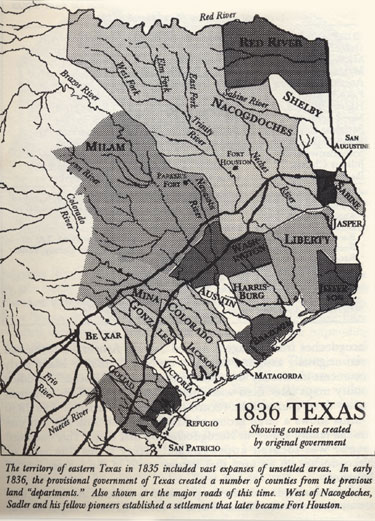
Map from the book, Taming Texas, by Stephen L. Moore
Five settlers were killed and five were captured, the most famous being Cynthia Ann Parker, who was "rescued" twenty-four years later by Sul Ross and Charles Goodnight at the Battle of Pease River. The remaining twenty-one survivors were split into two groups. Both groups made their way toward Fort Houston, near the present city of Palestine. The smaller group consisted of the men out working in the fields at the time of the attack. They returned to the fort after dark, took the remaining horses, and after finding "Granny" Parker, left for Fort Houston. The larger group took six nights to travel the sixty miles, with only two skunks and two sand turtles to eat.
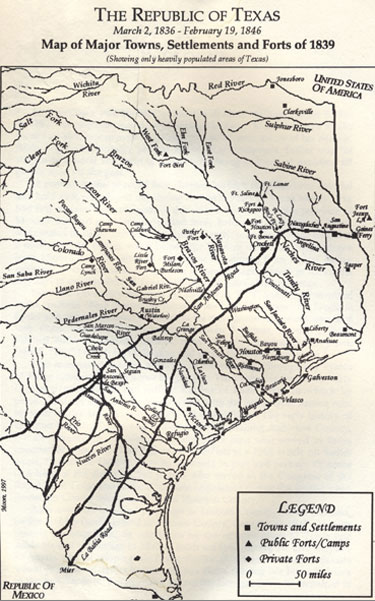
Map from the book, Taming Texas, by Stephen L. Moore
Directions From Fort Worth
Take I-35 South to Hillsboro. Exit Highway 36 to Corsicana at Hillsboro and continue east until a mile or so out of Hillsboro. Take the right fork to Hwy 171 to Mexia. Go through Mexia. Seven more miles down Highway 14 you'll see the entrance to the Old Fort Parker on the right. Take Park Road 35 for 1 mile.
Wendi Lundquist on Parker's Fort:
John Parker, an elder in the Predestinarian Baptist Church, left Illinois to settle in Texas in 1834 intending to spread the word of the Baptist Church to those who had not yet heard. He brought his wife "Granny" Parker, two sons Silas and Benjamin, and 4 grandchildren. Samuel Frost and his son also accompanied the Parkers on their quest. In March of that year, for protection from the natives that controlled this area, they built a fort in Limestone County along the headwaters of the Navasota River. It had log walls that were twelve feet high and two blockhouses on opposite corners to offer a view of far off distances and warn the occupants of approaching danger. For lodging, there were six small cabins inside the fort's walls.
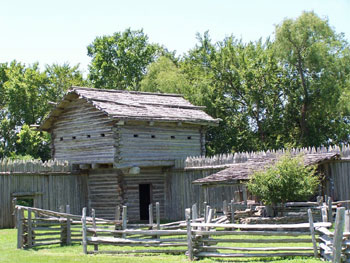
When John and his wife Sarah first built Fort Parker, it housed a company of Rangers from time to time as they were dispatched in the area to confront the Indians, either to retrieve stolen livestock or merely avenge the death of a fellow frontiersman. One company, under the command of Captain Robert Coleman, sought a fortress there in July of 1835 when the Tawakoni village they attacked proved to be surprisingly resilient. Colonel John Moore answered Coleman's cry for help with three companies of Rangers under his command. In August, the combined forces left Fort Parker and headed northwest, following a similar path to the one that we used for our approach to the fort. They found the village abandoned, and one ranger, Major Erath, who would soon establish the city of Waco, noted that the Indians were forced to leave behind a great store of crops, including sixty acres of corn.
Even though the Parkers and their extended family were far more prepared than most of the early settlers in Texas, their name and the misfortunes that befell them eventually became a significant part of the legend of the old Frontier. I've noticed that anyone who knows the slightest bit of this area's history can rattle off the names of Cynthia Ann and Quanah Parker without their eyes first glazing over as they wander backward into the days of Mrs. So-and-So's Seventh Grade history class. Here's why.
On May 19, 1836, long after Coleman and Moore's Ranger battalion had disbanded, more than one hundred Indians from Comanche, Kiowa and Wichita tribes appeared at the gates of the fort to ask for beef and directions to a water source. They were waving a white flag. Most of the men who could defend the fort were not inside those twelve foot walls; they were working in the surrounding fields. Old John Parker and his sons were inside, so Benjamin slowly opened the heavy gates to hear their requests. He went back inside the fort to relay this conversation to the others. When he returned to the gates to talk to the warriors, planning to send them toward water and deny them a cow, they quickly drove their lances through him and charged the open gates before they could be closed.
What followed was a bloody violent storm like nothing these Baptist immigrants had ever seen. The Indians pinned their victims to the ground with their lances, mutilated and murdered the men, and raped the women, including Granny Parker. They took five captives, young Cinthia Ann and John Parker, James Plummer, and two young ladies, Elizabeth Kellogg and Rachel Plummer. Though none would welcome such a title, these were the first white captives taken by Indians in Texas. Elizabeth Kellogg was taken by the Caddoans when the raiding band split their ranks, and she was soon traded to agents in Nacogdoches for $150. Rachel Plummer and the children traveled with the Indians all the way to eastern Colorado, where she too was eventually ransomed. Little John Parker and James Plummer remained for 6 years in captivity before they were ransomed in 1842. Cynthia Ann alone assimilated to her new way of life and rose to become a squaw named Naduah. Her story becomes legend because she was adopted into a Comanche family, and as she matured, she assumed the role of wife to the mighty chief Peta Nocona. The Comanche men practiced polygamy, and it seems a great testament to their relationship that Nocona never took another wife.
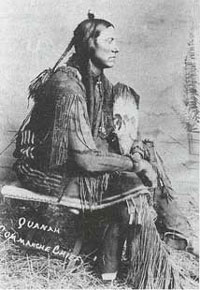
Photo from the Western History Collections, University of Oklahoma Library
Cynthia Ann embraced the Native American culture, and she prevented several of the whites' attempts to rescue her. She and Chief Nocona had three children; her firstborn son Quanah arose to become the most revered of Comanche chiefs. It is curious that one small captive child from a prominent local family could so win the hearts and respect of the Comanches that she would become the only wife of one great chief and the mother of his successor. When she was returned to the Parker family, after 24 years with the tribe, she resisted vehemently, trying a few times to escape. Cynthia Ann's tale twists the classic Cowboys and Indians story so that there can never be the clearly defined lines of hero and villain, no white horse and black horse. In this great legend that describes the beginning of the Texas frontier, the heroes are those whose indelible courage and tenacity have etched their names into the books of history, not merely those who ended up with the land in the end.

Photo of the Fort Parker compound taken by Charles M. Robinson, III from the book, Frontier Forts of Texas.
Parker's Fort sits on the northern end and was an important
part of the early Republic of Texas settlements.
In several accounts not included here, emphasis was placed on a situation
that had developed near Parker's Fort several months before the raid.
There were a handful of other family forts or camps scattered around
Parker's Fort that represented the vanguard of Anglo settlement on the
Middle Brazos. Like the leading edge of the frontier on the Colorado,
there was little control of the behavior of the individual settlements.
The Brazos pioneers claimed that a camp of thieves swindled a passing
Comanche band in a horse trade. Some believed that at least one of the
tribe had been killed. Colony records clearly indicate that the mistreatment
of the Caddos and the killing of Chief Dorcha had sparked a war and
that the Parker's Fort raiders invoked the chief's name during their
attack.
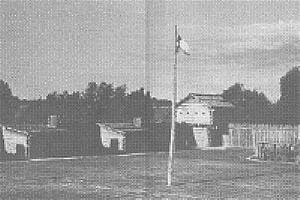
Caddos and Others Raid
Bastrop With Choctaw Tom
Fort Tours Chief Scout, Steve "Cougar" Nichols,
summarizes the records of Robertson Colony.
The Robertson colonists employed a friendly Caddo chief
named Canoma to go among the savages in 1835 and endeavor to bring
them in for the purpose of making a treaty and recovering two children
of a Mr. Moss who were then prisoners in their hands. This same chief
had pursued some Indians who had murdered H. Reed near Tenoxtitlan
in 1832 and recovered Reed's horse and saddle and returned them to
his father.
Canoma left two of his children as hostages, undertook
the mission, and visited several tribes. When he came back he reported
that those he had seen were willing to make a treaty with the Brazos
people but that about half of them were bitterly opposed to forming
friendly relations with the settlers along the Colorado. In fact,
at that very moment, he said, a party of the irreconcilable Indians
was making a descent on Bastrop. The people at the Falls of the Brazos
sent a runner, Samuel McFall, to warn the people of Bastrop but by
the time he got there the Indians had already entered the settlement,
and on June 1, 1835 they had attacked a wagon on the road from San
Felipe to Bastrop on the waters of Cummins Creek and killed Amos Alexander
and his son and escaped with the goods from the wagon.
In the meantime, two immigrants named Warnick and Elam
had stopped at the Falls of the Brazos and while there they were both
taken sick and their horses, turned loose to graze, ran away across
the Brazos and Little River and on down to Brushy Creek. Mr. Marlin
employed two Caddo chiefs, Canoma and Dorcha (or Douchey) to retrieve
the horses if possible. When they started, Mr. Marlin presented each
with a new shirt.
The Indians trailed the horses to Brushy Creek where
a short time before this, Indians from other tribes had been committing
depredations on the settlers around Bastrop. Some of these settlers,
under Colonel Edward Burleson, had decided to follow the Indians that
had been troubling them. The trail led to Brushy Creek where they
found Canoma and Dorcha with the American horses in their possession.
The posse immediately thought these were the Indians
who had been troubling them and in their rage and excitement decided
to kill the two chiefs forthwith. The two Caddos told them that Marlin
had sent them after the horses and showed them the new shirts Marlin
had given them and begged the settlers to go with them to the Falls,
less than thirty miles distant, where their story could be verified
but this request was denied.
Moses Cummins wrote Empresario Robertson relating these
events. He recommended that Robertson write Burleson a letter and
have someone carry it to him immediately before these citizens, in
their rage, could do violence "to those innocent Indians."
The Burleson party had gone up to the country taking Canoma and Dorcha
with them and Cummins said that their trail could be easily found
somewhere between the heads of Cow Bayou and the Leon River. Burleson
had agreed not to harm the Indians without bringing them into the
settlement for a hearing but his men were enraged and crying for blood.
"Such men," Cummins wrote, "in such a state of mind,
are not apt to discriminate between guilt and innocence."
Cummins was right in his prediction. Colonel Burleson
was unable to control the mob psychology of his men. They tied Canoma
and his son to trees and shot them, leaving his wife to get home as
best she could. Stephen Townsend and John Rabb, two members of the
party opposed to the killing but unable to prevent it, left the company
rather than witness what they deemed to be murder.
Canoma's wife wasted no time getting back to the settlement
where she reported the facts exactly as they had happened. This so
incensed the remainder of Canoma's people, who were still at the Falls,
that Choctaw Tom, the principal man left amongst them, stated that
they could not blame the people at the Falls, but that all the Indians
would now make war on the settlers along the Colorado. With all the
band, he left for Indian country.
The young warriors notified the settlers near Mr. Marlin
that they were going to make war on the whites but promised that they
would never molest the whites in that locality. They kept this promise
for about twelve months. Then the name of Chief Dorcha turned up in
the attack on Fort Parker on May 19, 1836. Later, the Caddos, Ionis,
Anadarkos and Kichais united under Chief Jose Maria and their terrible
butchery and pillaging began. One of the first families murdered was
one of those whom the Caddos had promised not to molest, the George
Morgan family, whose home they attacked on January 1, 1839.
The following is from the book, The Men Who Wear the Star,
by Charles M. Robinson, III:
In July, 1835, a company of men under Capt. Robert M. Coleman attacked
a Tawakoni village in what is now Limestone County, east of Waco.
Though surprised, the Indians outnumbered the whites, forcing them
to retreat to Parker's Fort, seat of the Parker clan, some forty
miles east of Waco. Coleman sent for help and was reinforced by
three companies under Col. John H. Moore. The Indians retreated.
Moore's Rangers combed the countryside as far as the present site
of Dallas before returning home. These various skirmishes, insignificant
on their own, would have far-reaching repercussions, not only with
the local tribes but with the powerful Comanches of the Plains.
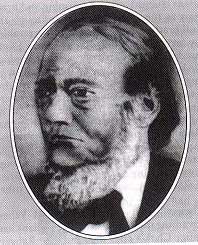
George Erath
In early August of 1835, Colonel Moore's Ranger's responded
to Coleman's bloody July encounter with the Tonkawas. The Colonel led
Ranger Captains Williamson, Barnett, Coe, Goheen and Coleman and their
companies northwest from Parker's Fort to even the score. Ranger George
Erath later wrote:
After waiting for the swollen Navasota to run down,
we marched on to the village. Texas Indians never allowed themselves
to be attacked by a hundred men together; they had evacuated the
village, and we had nothing to do but occupy it. We found sixty
acres in corn, which was just hard enough to be gritted, and by
making holes in the bottom of the tin cups we carried we fashioned
graters, and supplied ourselves with bread. There were also numbers
of pumpkins, watermelons, muskmelons, peas and other vegetables,
such as were then raised by Indians in their primitive agriculture.
Two days later the troops were on Post Oak Creek when
scouts reported Indians ahead. Erath comments that Moore "took
as much precaution as if we were about to fight such formidable foes
as Creeks, Cherokees, and Seminoles-foes the two had faced in their
younger days under Jackson." Battle lines were formed. Erath further
wrote:
I was riding a young horse which had been caught a colt from
the mustangs, that was fiery. When the order came to charge, it
darted forward ahead of all the rest, and I found myself alone
in the advance. Next came McFall, who was also on a wild horse,
too eager for the fray. The officers shouted to us to come back
into line, but our efforts to obey were in vain. Our steeds had
determined to give us a reputation for bravery which we did not
deserve.
The incident also earned Erath the nickname, "The
Flying Dutchman". The battalion trudged on northwest until the
end of August when the Rangers enlistments began to expire and many
chose to return to their families. Erath continues:
The main body of the Indians were never overtaken; but several
small scattering parties were met, with which there was some skirmishing.
The Texan forces kept daily diminishing, and in two months the
expedition closed.
Moore led the remaining volunteers to the forks of the Trinity, where
Dallas now stands, before turning back to the southeast, passing through
the future site of Fort Graham. The force returned to Moore's Fort
in Mina (present day Bastrop) and disbanded.
The Parker family built a log stockade deep in the Brazos
valley near the Navasota River. Several other families joined them,
swelling their settlement to over thirty pioneers. Only two other
families built cabins, although the rich land was heavily timbered
with oak and abundant in good water and game. On May 19, 1836, at
least one hundred mostly young and mostly Comanche warriors appeared
at the gates of the fort. The only men at the fort were elderly John
Parker, his son Silas and Benjamin, Samuel Frost and his son. Benjamin
walked outside to talk to the Indians who were brandishing a white
flag. Silas, protective of his four young children and wife, stayed
at the gate. The Indians demanded beef and directions to the watering
hole. Benjamin walked back and told his brother he had refused them
the beef but would go back and try to talk them into leaving peacefully.
From the book, Comanches, The Destruction of a People,
by T.R. Fehrenbach:
The people in the fort saw the riders suddenly surround
him and drive their lances into him. Then, with loud whoops, mounted
warriors dashed for the gate. Silas Parker was cut down before he
could bar their entry; horsemen poured inside the walls. The two
Frosts, father and son, died in front of the women; Elder John Parker,
his wife, "Granny," and the others tried to flee. The
warriors scattered and rode them down.
There were a few, brief, murderous moments of horror
and wild confusion inside the fort. Several warriors seized John
Parker and his wife; others rode after the other women and children,
in a shrieking, bloody melee.
The early sixteenth- and seventeenth-century European
accounts of Amerindian warfare usually recorded events in stark
simplicity. This was no longer true by the nineteenth century. Reports
became clothed in Victorian delicacy; newspaper accounts and even
military records obscured details with awkward euphemisms. Such
understatements may have obscured the true nature of events for
readers who had never come into personal contact with the frontier,
though they deceived no one on the frontier itself. The newspapers
of the day printed sanitized versions, often quoted by historians.
But what happened was that John Parker was pinned
to the ground; he was scalped and his genitals ripped off. Then
he was killed and further mutilated. Granny Parker was stripped
and fixed to the earth with a lance driven through her flesh. Several
warriors raped her while she screamed. The other women were seized
and attacked; two were seriously injured and left with gaping wounds.
Silas Parker's wife Lucy fled through the gate, shepherding
her four small children. But the riders overtook her near the river;
they threw her and the children over their horses to take them back.
Now, however, men were running from the fields with rifles. One
David Faulkenberry, a brave soul, rushed to Lucy Parker's rescue.
He forced the warriors to drop Lucy and two of the children, but
one made off with Cynthia Ann and John Parker, aged nine and six.
Then, as more Parker men arrived, the entire war party leaped for
its horses and galloped away from the confining space of the stockade.
The horde could have killed all the whites in the vicinity, but
the warriors were satisfied with the great triumph they had scored,
by their lights, without casualties. They rode north in a cloud
of dust toward the Trinity.
They killed the five men in the fort and left three
women raped, speared, mutilated and bleeding to death, including Granny
Parker. Two of the women died, but Granny, a tough old bird, removed
the lance she had been pinned down with and survived. Elizabeth Kellogg,
Rachel Plummer, her infant son James, and two small Parker children
had the distinction of being the first American captives of the Comanches.
The prisoners were tied to horses and spirited along the warriors'
retreat toward the Trinity. They made camp long after midnight and
held a victory dance where individual warriors recounted his exploits,
occasionally waving about a bloody scalp. The prisoners were kicked
and whipped during the dance, then the captive women, in view of the
children, were tortured more extensively and raped repeatedly until
dawn.
From the book, Comanches, The Destruction of a People,
by T.R. Fehrenbach:
Elizabeth Kellogg and Rachel Plummer, both married
women, were the first American females known to be taken captive
by Comanches. They were treated no differently from women of the
Pawnees or Utes. In the reservation years, when Indians were being
tried and hanged for "crimes" against the whites, few
Comanches, logically, ever admitted to the taking or abuse of captives,
and their descendants tended emotionally to deny rapes and tortures
for the same reasons that descendants of the Aztecs tried to deny
that the Mexica ceremonially ate human flesh. However, to the Plains
tribes all females were chattels, and despite a great deal of studied
delicacy on the subject, there was never to be a known case of white
women captives who were not subjected to abuse and rape. When they
could be led to talk, returned captives told the same story, and
until the last half of the nineteenth century, Comanche warriors
proudly asserted such exploits.
After such initiations, few women ever put up any
serious resistance. It was in fact utterly impossible for a captive
female to defy a Comanche warrior. The men might kill a troublesome
female out of exasperation, but they usually used equally direct
but more imaginative means to secure obedience. A captive was always
exhausted, bound, and stripped naked in the warrior's presence.
The Comanches did not need to use crippling tortures on a captive
they wanted to keep. One simple tactic was to make captives run
behind a horse, hands bound and attached to the rider by a thong.
Bare legs and feet were cruelly lacerated by stones and thorns,
and if the captive stumbled or fell from exhaustion, dragging caused
exquisite pain. Caucasian captives who were made to walk or ride
nude under the southwestern sun suffered agonizing sunburns. Captives
quickly learned that complete cooperation was infinitely preferable
to the punishments the warriors could devise. There is no record,
despite white myths, of women destroying themselves under such circumstances.
They clung to life and avoided punishment. Once far out on the plains
the captors no longer bothered to keep captives bound, for escape
into the wilds meant certain death from thirst or starvation.
Elizabeth Kellogg and Rachel Plummer survived their
initial ordeal, the first of many.
That morning, the war party split up. The Nocona Comanche
and a few Kiowa, who had been riding with them, rode west on the plains,
the Comanche split off north, taking Rachel and the children with
them to eastern Colorado. The children, being so young, were adopted
and adapted easily to Comanche life. Rachel was completely degraded,
forced to be a warrior's slave, tortured and beaten by her master,
his other wives and female relatives. Soon she bore a child and as
she lost or at least temporarily managed to forget her memories of
civilization, she began to savagely assert herself, earning the respected
position as a wife and mother of the Comanche.
A handful of Wichita and Caddoes, who participated in
the raid, claimed Elizabeth Kellogg and took her with them to the
Red River, where she was traded to some Delawares for one hundred
fifty dollars worth of goods. They took her to Nacogdoches and sold
her to officials of the Republic of Texas for what they had paid.
Within a year, Rachel was seen by Comancheros, who spoke
of it when they returned to Santa Fe. An American trader named Donohue
heard the news and commissioned the Comancheros to buy the captives
from the Comanches. They could only purchase Rachel, and after eighteen
months of captivity, she was taken to Santa Fe. Donohue and his wife
took Rachel across the trail east to Independence, Missouri, where
she rendezvoused with a relative who took her home to Texas.
From the book, Comanches, The Destruction of a People,
by T.R. Fehrenbach:
The position of a returned female captive, however,
was always anomalous on the nineteenth-century American frontier.
The frontiers's puritanical views and rigid racial and sexual shibboleths
made it impossible for such unfortunate women to be accepted gracefully
back into their communities. They were objects of sincere pity,
but they were also considered dirty and disgraced, for they had
been the playthings of creatures the Americans regarded as animals.
They were embarrassments to their families. Some husbands would
not receive them or live again with them. Ironically, most returned
women suffered more real shame and humiliation among their own people
than among the Comanches. If they came back with half-breed children,
their position, and that of the unhappy children, was even more
unfortunate. When they could, such women left the frontier and all
old associations forever. Rachel Plummer died within less than a
year after her ransom and return to civilization.
Six years of constant pressure on behalf of the Parker
family finally resulted in the ransoming of John Parker and James
Plummer. James, the youngest, managed to readapt to civilization but
John was older and had become a Comanche warrior. He longed to return
to his tribe and his sister, Cynthia Ann, who had become the wife
of Peta Nacona, an important warrior with whom she had three children.
John soon ran away from Parker's fort but he never found his sister
and ended up living south of the Rio Grande.
From the book, Comanches, The Destruction of a People,
by T.R. Fehrenbach:
There was no evidence that she (Cynthia Ann) was unhappy
on the plains. However, the knowledge that she was a Comanche "squaw" continually fed dark racial and sexual angers across the Texas frontier.
A spark of violence and hatred had been lit at Parker's Fort that
dogged the Parker blood, and its continuing reverberations would
last till the twilight of the Texan-Comanche wars.
Parker's Fort was the beginning of the longest and
bloodiest of all the wars between the Anglo-Americans and any single
Amerindian people. As if it were a tocsin, in 1836, the western
regions of Texas began to flame from Comanche raids. The bands quickly
expanded their warfare to include the Texans; they had found the
range. The Parker raid was only the first of hundreds like it, which
spread killings, tortures, rapes, and tragic captivities all across
the borderlands. This was not a frontier of military forts or towns,
or of traders and trappers, like so much of the contemporary United
States' plains frontier. The Texans were moving thousands of unprotected
farming families west. Following their individual stars, the Anglo-Texans
pressed on. In the 1830s, what was then west Texas became a bloody
ground, filled with pioneer families who had lost fathers and sons,
wives and daughters, who had buried their mutilated dead and ransomed
young women who returned with demented stares. In a few months blows
were struck and insults given that the Texan people could neither
forget nor forgive… The Comanches who now found splendid raiding
opportunities down the Brazos and the Colorado were also incapable
of understanding the Texan-Americans. They did not perceive that
this was a people unlike the other Europeans they had met. Texans
appears to be peasants blundering onto the plains-miserable, grubbing
people whose seat in the saddle brought smiles to Comanche warriors'
lips; who seemed to fear war and lacked war skills, and who recklessly
exposed their women and children.
The People failed to sense the deep-seated belligerence
of the Texan-Americans toward anyone who opposed or injured them,
or who aroused their passion or contempt. The Texans were not cruel;
they lacked the cruelty as well as the subtlety of the Spanish and
the French. But they were vastly more brutal and ruthless in sustained
determination. That determination was immediately apparent. The
shattered Parker clan did not desert the far frontier. It went back
to Parker's Fort, tended the fields, and harvested the ripening
corn. The men now went armed and vigilant, distrusting and despising
all Amerindians. The settlement prospered, and as other hundreds
slowly joined them in this country, the family grew prominent in
the region.
But Parker's Fort had begun an ethnic-racial war in
which there would be no more moral boundaries than territorial ones
between the races on the Texas prairies. People who had been raided,
who buried their rotting dead and prayed for captured loved ones,
only affirmed the old American proverb that the only good Indian
was a dead one.
Communities and Related Links
|